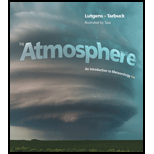Solutions for The Atmosphere: An Introduction to Meteorology (13th Edition) (MasteringMeteorology Series)
Browse All Chapters of This Textbook
Book Details
For introductory meteorology courses.
Providing the perfect storm of rich media and active learning tools.
The Atmosphere: An Introduction to Meteorology remains the definitive introductory meteorology text, reinforcing basic concepts with everyday, easy-to-grasp examples. This revision retains the hallmark features professors have come to expect from Tarbuck and Lutgens: a friendly, largely non-technical narrative, timely coverage of recent atmospheric events, and carefully crafted artwork by leading science illustrator Dennis Tasa.
The Thirteenth Edition now incorporates a new active-learning approach, integrated mobile media, and MasteringMeteorology, the most complete, easy-to-use, engaging tutorial and assessment tool available.This edition also extends its coverage of global climate change with dedicated climate change features in each chapter, coverage of the IPCC 5th Assessment report, and an inquiry-based approach in updated Student Sometimes Ask features with interesting facts that strengthen the connection between students and the content.
Also available with MasteringMeteorology.
MasteringMeteorology is an online homework, tutorial, and assessment product designed to improve results by helping students quickly master concepts. Students benefit from self-paced activities that feature immediate wrong-answer feedback and hints that emulate the office-hour experience to help keep students on track. With a wide range of interactive, engaging, and assignable activities, students are encouraged to actively learn and retain tough course concepts.
Sample Solutions for this Textbook
We offer sample solutions for The Atmosphere: An Introduction to Meteorology (13th Edition) (MasteringMeteorology Series) homework problems. See examples below:
More Editions of This Book
Corresponding editions of this textbook are also available below:
